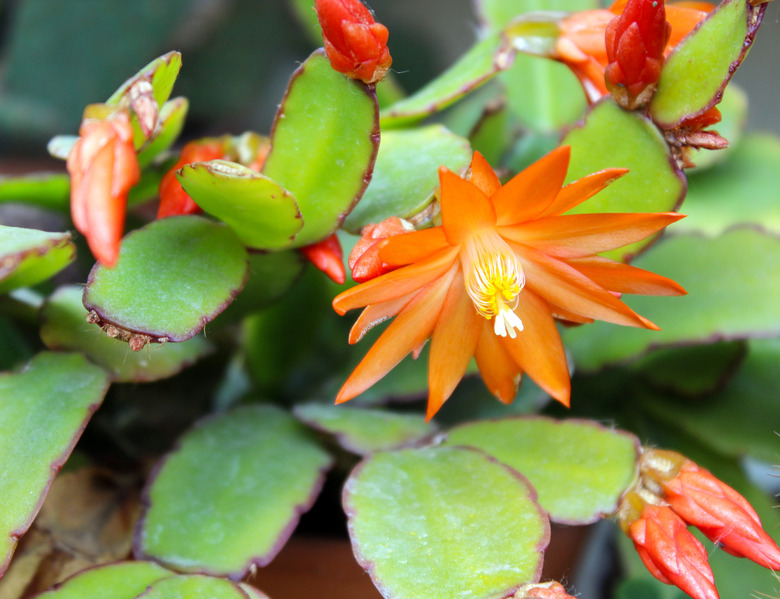How To Propagate Easter Cactus
As one of a trio of plants collectively called "holiday cacti," Easter cactus (Rhipsalidopsis gaertneri, formerly Hatiora gaertneri) shares some traits with its holiday counterparts while also displaying some marked differences. Rounding out this trio are Thanksgiving cactus (Schlumbergera truncata) and Christmas cactus (Schlumbergera x buckleyi).
Blooming seasons for these three plants correspond to their common names, with Thanksgiving cactus typically flowering in early winter, Christmas cactus in late winter and Easter cactus in springtime.
As a spring bloomer, Easter cactus is set apart from the other two holiday cacti by claiming a blooming season all its own. This species also has differently shaped flowers, which is one definitive way to identify it.
It's easy to propagate your Easter cactus by following a few tried-and-true tips, which will allow you to start many new plants to keep or gift to family and friends.
Holiday Cacti Identification
All holiday cactus plants are native to rainforests in Brazil, classifying them as tropical cacti instead of desert cacti. These tropical plants are hardy only in USDA plant hardiness zones 10 through 12, which is why they're grown as houseplants in almost all U.S. climates after they're purchased as holiday plants.
Thanksgiving and Christmas cactus plants are easily confused, in part because their blooming periods sometimes overlap, but mostly because Thanksgiving cactus plants are marketed as Christmas cactus plants. Confusing? You bet. But the reason is a marketing ploy.
Because Thanksgiving cactus plants start blooming just ahead of the Christmas season, these are the plants you see in garden centers and grocery stores marketed as Christmas cacti. "True" Christmas cactus plants generally bloom shortly after Christmas and often through February, so their marketing value as Christmas plants falls flat.
The key to correct species identification lies in the appearance of the cladodes, also called cladophylls, which are the flattened stem segments on all holiday cactus plants. Although they may look like leaf segments, botanically, they're stems that function as leaves primarily because of their photosynthetic capability.
Thanksgiving cactus plants have soft, spiny edges on their cladodes that look like crab claws. Christmas cactus plants have teardrop-shaped, scalloped cladodes, and **Easter cactus plants have round, scalloped edges.**
Unlike Thanksgiving and Christmas cactus plants that have tubular flowers, Easter cactus flowers are starburst or star-shaped blooms that are also described as funnelform. Easter cactus flower colors include pink, red, orange and white.
Easter Cactus Propagation
Propagating some plants is so hit or miss that it sometimes entails throwing a Hail Mary pass and hoping for the best. Then, there are some plants, such as Easter cactus, for which propagation is so easy that even novice gardeners enjoy high success rates. The stem segments easily root, and you'll often see roots already growing at the joints where individual segments meet.
Although you can cut or clip individual stem segments from the main stem, there's an easier technique that's sure to remove the proper amount of each segment. Follow these tips and you're sure to have success:
1. After watering your plant the day before to hydrate the stems, simply grasp a stem segment at the tip of the main stem and twist it around and around until it naturally breaks at the joint. 2. Set the stem segment(s) on the kitchen counter out of direct sunlight and let the severed end heal over for a couple of days. 3. Instead of using rich potting mix, fill a very small container with seed-starting mix or equal amounts of vermiculite (or perlite) and peat moss (or coir). A 3-ounce plastic cup with a drainage hole pierced in the bottom works well for rooting stem segments, which you can place two or three per cup. 4. Gently press the cut end of each stem segment into the rooting mix to a depth of about 1/4 the length of the segment. 5. Add water until it freely drains from the bottom of the pot. 6. Keep the stem segments in bright light or indirect light but out of direct sunlight and water once or twice a week to keep the rooting medium slightly moist but not wet, which can promote root rot or even rot the segments themselves. It's better to let the medium slightly dry before lightly watering again. 7. The segments will form roots in just two to three weeks.
Tip
When caring for an Easter cactus, less water, less fertilizer and less sunlight than you'd give most of your houseplants is the best regimen to follow for optimal health.
Easter Cactus Care
Caring for your new Easter cactus plant follows the rule of thumb that "less is more." In other words, less water, less fertilizer and less sunlight than you'd give most of your houseplants is the best regimen to follow for optimal health.
Once the segments are well rooted, repot them into a 4- to 6-inch pot using a potting mix with components that allow good aeration, such as vermiculite or perlite. Clay pots work well because they "breathe" and allow excess water to escape.
As succulents, Easter cactus plants don't need a lot of water, which can actually be detrimental and result in root rot, so water with a light hand. Use a balanced fertilizer formulated for flowering houseplants only once monthly during the active growing season.
If you set your plant outside in late spring, be sure to keep it in a shady spot that receives indirect sunlight but no direct sun. Cooler temperatures in autumn will trigger your plant to begin forming buds, which may not be visible until early spring just before your Easter cactus blooms.

